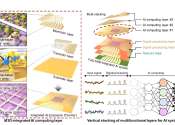Can a computer chip have zero energy loss in 1.58 dimensions?
What if we could find a way to make electric currents flow, without energy loss? A promising approach for this involves using materials known as topological insulators. They are known to exist in one (wire), two (sheet) and ...









